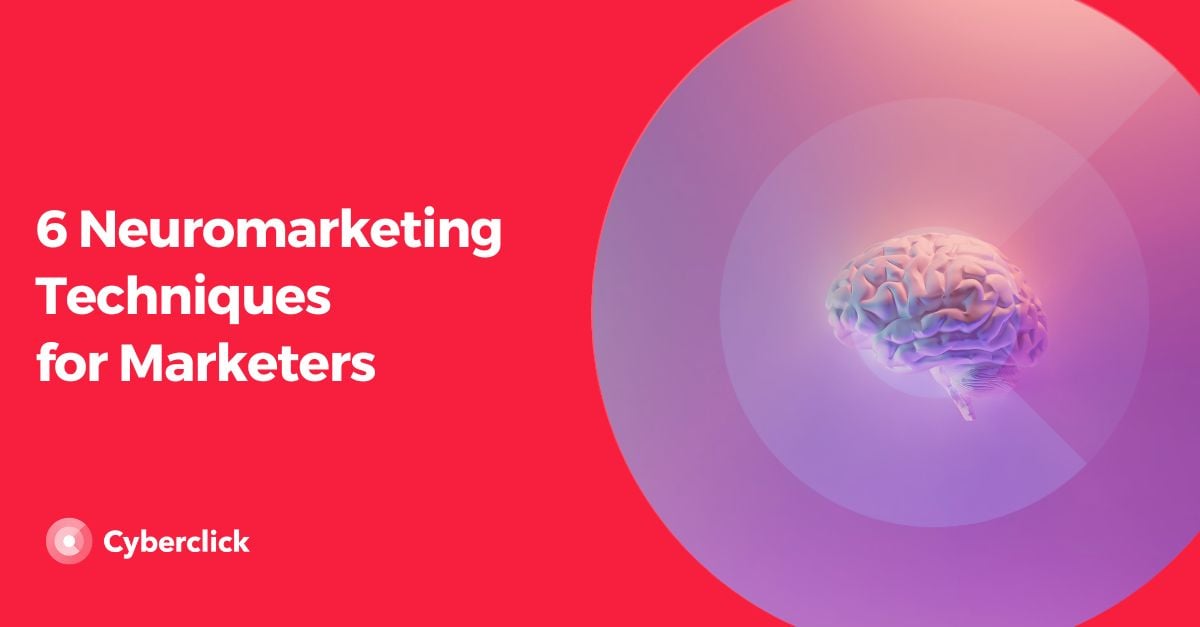Sometimes digital marketing can feel a bit like fortune-telling. What is really going on in your consumers’ minds and what can you do to make them notice our brand?
Luckily, as the years have gone by, marketing has become more and more of a science and less of an art. One of the clearest examples of this is neuromarketing, as scientific subject that that applies neuroscience to marketing to try understand how the consumer’s brain works and which areas of the brain should be activated in order to entice purchase. To help you get started, we're sharing 5 neuromarketing techniques that can help you stand out in your ideal customer’s mind.
6 Neuromarketing Techniques to Understand Your Clients Better
1. Eye Tracking: See Things Through Your Customer’s Eyes
As the name indicates, eye tracking consists of following the eye movements of people participating in a study. It is a tool that allows your brand to see through your potential clients’ eyes, not only in labs, but in real purchasing scenarios as well.
As modern eye tracking devices are very small and light, the participants in the study can wear them while going shopping or while watching TV. Based on this, brands can answer a series of questions:
- How much attention do consumers pay to items promoted near the store’s entrance?
- Do clients really read posters and billboards, or do they just glance at them without reading?
- How do they distribute their attention when choosing a product from a shelf?
- Do they pay attention to product placement when watching TV?
As you can see, eye tracking opens up a whole world of possibilities for marketing studies.
2. Pupillometry: Take a Look at Your Customer's Eyes
Pupillometry does something quite simple: it looks at the size of a person's pupils to see if they are dilated or not. The reason that this metric is important is because a person's pupils dilate when they are looking at something they like.
This can be useful in marketing because, not only does it indicate whether or not people like a product, but also it can be used to optimize a great deal of things, from websites to packaging. Having a visually pleasing website or advertisement will generate a greater rate of engagement from the public. This in turn can increase brand awareness and sales.
Luckily, pupillometry is relatively inexpensive. It can also be used in conjunction with other neuromarketing tools such as eye tracking and biometrics.
3. EEG or Functional MRI: A Trip Inside the Brain
Thanks to neuromarketing techniques, we can go a step further. Not only can we know exactly what people are looking at, but we can also get clues as to what they are thinking. How? By using devices that specialize in reading the brain’s electromagnetic activity, such as functional MRIs or electroencephalograms (EEG).
Marketers can use these to really get to know consumers’ preferences like if they feel attracted or repelled by a given feature and whether your brand interests or bores them. In the end, we obtain the answers to the same questions as traditional marketing studies, but with much greater accuracy and scientific proof.
Both “mind-reading” techniques have both advantages and disadvantages.
- The electroencephalogram is very time-sensitive and accurate - it can relate a stimulant to its reaction almost immediately, which is what makes it so useful to figure out exactly which element provides which kinds of feelings in the user. However, when it comes to locating which area of the brain causes this reaction, its precision is reduced .
- On the other hand, the functional MRI tells you exactly which parts of the brain are being activated, with a somewhat lower time precision.
4. Facial Coding: A Smile Is Worth a Thousand Words
Neuromarketing has converted the art of interpreting facial expressions into something of a science.
Just as neuromarketing techniques can be used to measure eye movements and brain activity, they can also be used to “read faces” with unprecedented precision.
The way it works is simple: when we smile, display anger or make any other kind of facial expression, we use our muscles to do it. By using sensors, these minute muscle movements can be accurately measured to detect expressions and emotions that people aren't even aware they are feeling.
Of course, a small smile or a grin don't show the absolute truth of what a person is feeling at that given moment, but facial coding help marketers by reading and interpreting subtle reactions that offer insights on people's opinions. They are sometimes even able to predict the behavior that will follow.
5. Sensory Marketing: Looks Aren't Everything
In addition to the techniques mentioned above, neuromarketing has more practical and functional applications, like sensory marketing.
By applying neuromarketing discoveries, we can impact consumers without them even knowing that we’re doing it. There are several forms of sensory marketing, such as through touch, sound, or smell. All of them, however, are based on influencing the audience to think of a certain brand in the presence of sensory stimulations.
Smell is a perfect example of the use of sensory marketing. Sometimes, getting a customer to make a purchase is as easy as influencing their senses with the right fragrance. A very common example are supermarkets who enhance the smell of fresh bread in order to attract people to the bakery section and encourage them to purchase.
Sounds are also a very useful resource. It has been proven, for example, that consumers pay more attention to lighter colored objects when they hear high pitched sounds, and darker objects when they hear low pitched sounds.
6. Neuromarketing Tricks
Last of all, we are going to address the psychological tricks used by neuromarketing in order to boost sales.
Psychological neuromarketing techniques can be very subtle. For example, it has been shown that removing the dollar or other currency sign from the price tag can make consumers purchase more. It seems that the currency symbol makes people think more about losing money than about what they will gain.
Another surprising example is the organization and structure of restaurant menus: visitors have higher chances of choosing healthy options when these are shown on the left hand side of the menu than is they are on the right.
Ethical Considerations in Applying Neuromarketing
While neuromarketing can offer insights into consumer behavior, it's important for marketers to approach it with a strong ethical framework. Transparency and consent need to be at the forefront of any neuromarketing strategy. Customers should be informed about the use of techniques like eye tracking, pupillometry, EEG, or facial coding, and their consent should be sought before any data is gathered.
Additionally, marketers must prioritize the responsible use of this information. While it can be used to enhance user experience, it should not focus on manipulating behavior. Striking a balance between leveraging the power of neuromarketing and respecting individual privacy is essential for maintaining customer trust and building loyalty with your audience. By adopting ethical standards when applying these techniques, marketers can benefit from neuromarketing while maintaining a commitment to the well-being of their audience.
Responsable de la estrategia de contenidos y visibilidad en Cyberclick, con enfoque Allbound y especialización en posicionamiento SEO, GEO y automatización con IA. Gestión avanzada del CRM con HubSpot: base de datos, workflows, lead nurturing, scoring y reporting. Experiencia en marketing digital, comunicación corporativa y periodismo, uniendo estrategia, creatividad y tecnología para captar y convertir leads cualificados.
Responsible for content and brand visibility strategy at Cyberclick, with an Allbound approach and specialization in SEO, GEO (Generative Engine Optimization), and AI-powered automation. Advanced HubSpot CRM management: database segmentation, workflows, lead nurturing, scoring, and reporting. Background in digital marketing, corporate communications, and journalism—combining strategy, creativity, and technology to attract and convert qualified leads.







Leave your comment and join the conversation